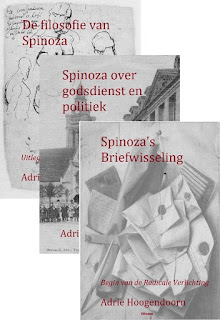Kort overzicht Britse Spinoza-receptie in de 17e eeuw
Anders dan in
Stuart Brown (Ed.), British Philosophy and the Age of Enlightenment. [Routledge History of Philosophy, Volume 5], Routledge, 2012 -– bookds.google
waaraan Sarah Hutton [Honorary Visiting Professor, Department of Philosophy, University of York, cf.] ook meewerkte, en dat hier en daar een verwijzing naar Spinoza heeft, biedt het volgende recent verschenen boek geheel van haar hand
S arah Hutton, British
Philosophy in the Seventeenth Century. [The Oxford History of Philosophy]
OUP Oxford, 2015 – books.en dat google – review in NDPR
arah Hutton, British
Philosophy in the Seventeenth Century. [The Oxford History of Philosophy]
OUP Oxford, 2015 – books.en dat google – review in NDPR
behalve eveneens hier en daar een verwijzing naar Spinoza, ook een aparte paragraaf waarin de receptie van Spinoza in Groot-Brittannië kort behandeld wordt. Dit nuttige korte overzicht neem ik hier graag in dit blog over (zonder de verwijzingen naar de voetnoten; daarvoor verwijs ik naar het boek zelf):
Spinoza
The philosophy of Baruch de Spinoza (1632-77) sent shock waves through the philosophical and ecclesiastical establishments at the end of the seventeenth century. However, Spinoza figures only peripherally in seventeenth-century British philosophy, largely for the reason that the notoriety which he so swiftly acquired obstructed impartial discussion of his philosophy. The first English translation of any of Spinoza's writings was by Charles Mount, whose Miracles, No Violations of the Laws of Nature (1683) includes Blount's translation of chapter 6 of Tractatus theologico-politicus. A part translation of the Tractatus theologico-politicus appeared in 1689, but most read him in Latin. Most references to his philosophy are negative. An exception to the chorus of vilification was Henry Oldenburg, who visited Spinoza in 1661 and entered into correspondence with him, by means of which he was a channel of communication between Spinoza and Boyle. However, particularly after the publication of Tractatus theologico-politicus, denunciations were the order of the day. Henry More led the way with two short pieces Epistola altera and Demonstrationem duarum (published in his Opera omnia, 1679). In Viscount Stair's Physiologia nova experintentalis of 1681, Spinoza figures as an 'execrable atheist', alongside Vanini, and `FIorrendus Hobbesius'. Spinoza's name even appears in university disputations for refutation (e.g. Alexander Cockburn's theses of 1679). Stillingfleet also attacked him, but Locke steered clear. The Boyle lectures provided fertile ground for attacks on Spinoza for atheism and impiety—a notable example being the celebrated sermons by Samuel Clarke who attacked Spinoza as `the most celebrated atheist of our time'.
According to Aubrey the Earl of Devonshire asked Hobbes's opinion on Spinoza's Tractatus theologico-politicus on its appearance in 1670. Hobbes is said to have responded ‘Ne judicate ne judicemini' (judge not lest you be judged'). Anne Conway was one of the few to make objections to Spinoza which weren't coloured by ad hominem remarks. She did not subscribe to the general interpretation of his single-substance monism as materialistic and atheistic, since she evidently saw parallels with her own substance monism. Her principal objection focused on his pantheism, his identification of God with nature (deus sive natura), that he 'confounded' God with created things. Richard Burthogge is another critic of Spinoza, remarkable for his measured tone. His Essay upon Reason and the Nature of Spirits (1694), criticizes Spinoza's conception of God on the grounds that it entails that God is infinite extension and does not exist necessarily.
As with Hobbes, Spinoza's works are to be found not only in the libraries of free thinkers like the merchant Benjamin Furly, but also in the book collections of those least likely to acknowledge an interest, for example James Nairn, Ralph Cudworth, and Stillingfieet. Notoriety generated curiosity: the Scottish Historiographer Royal James Fall was probably not untypical when he said of Tractatus theologico-politicus that he was 'sorry such books are printed but since they are my curiosity leads me to desire a sight of them'. And it was not uncommon for those suspected of materialism to be branded Spinozists, as was Locke by William Carroll. Matthias Earbery identified Spinoza as a deist in his Deism Examined and Confuted (1697), linking Spinozism with scepticism. Like Henry More, he attributed Spinoza's errors to his uncritical absorption of Cartesianism. Earbery also identifies Gassendi as a source. The interest shown in Spinoza by subversive figures like Toland (in Letters to Serena) and Blount only served to confirm the suspicions of his detractors who regarded him as a materialist atheist. Herbert of Cherbury was accorded the dubious distinction of being yoked together with Spinoza and Hobbes in Christian Korholt's De tribus impostoribus magnis (1680, reprinted 1700) (Of the Three Great Impostors). Subsequently, Jean Colerus' biography, La Vie de Spinoza (1705), helped to mitigate the predominantly negative view of Spinoza. An English translation of this was published in London in 1705.
As this brief survey shows, seventeenth-century Britons kept abreast of the latest thinking in contemporary philosophy as well as with current interpretations of ancient philosophy. In at least two cases a renewed dialogue with past philosophy was mediated via contemporary Europeans (Grotius and Gassendi for scepticism and Epicureanism). British philosophers were thus in conversation not just with one another, but with European philosophy, old and new. For the most part, these conversations took place in a non-institutional context, outside the universities.

